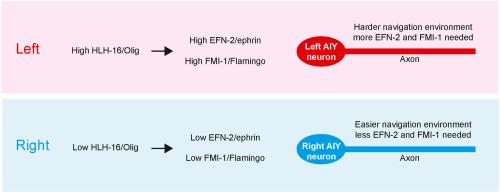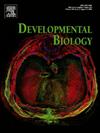左右不对称表达的ephrin和Flamingo蛋白调控秀丽隐杆线虫侧向轴突生长
IF 2.5
3区 生物学
Q2 DEVELOPMENTAL BIOLOGY
引用次数: 0
摘要
虽然两栖动物的神经系统在解剖学水平上主要是左右(L-R)对称的,但也存在一些分子和功能上的 L-R 不对称。然而,这些分子不对称的程度及其功能性后果的特征仍然不甚明了。通过 elegans 可以以单神经元分辨率研究神经系统中的 L-R 不对称现象。我们之前已经证明,神经 bHLH 转录因子 HLH-16/Olig 在 AIY 神经元系中以 L-R 不对称方式表达,并以 L-R 不对称方式调节 AIY 轴突的投射。在这里,我们结合候选方法和单细胞 RNA 测序数据分析,确定了表皮蛋白 EFN-2 和 Flamingo 蛋白 FMI-1 作为 HLH-16 的下游靶标,它们在 AIY 系中以 L-R 不对称方式表达。我们的研究表明,EFN-2和FMI-1在轴突生长的L-R非对称调控中相互协作。EFN-2可能通过L1CAM家族的非经典受体SAX-7发挥作用。我们的研究揭示了秀丽隐杆线虫神经系统中新颖的分子 L-R 不对称现象及其功能性后果。本文章由计算机程序翻译,如有差异,请以英文原文为准。

Left/right asymmetrically expressed ephrin and Flamingo proteins regulate lateralized axon growth in C. elegans
While the nervous system of bilaterian animals is mainly left-right (L-R) symmetric at the anatomical level, some molecular and functional L-R asymmetries exist. However, the extent of these molecular asymmetries and their functional consequences remain poorly characterized. C. elegans allows to study L-R asymmetries in the nervous system with single-neuron resolution. We have previously shown that a neural bHLH transcription factor, HLH-16/Olig, is L-R asymmetrically expressed in the AIY neuron lineage and regulates AIY axon projections in a L-R asymmetric manner. Here, by combining a candidate approach and single-cell RNA sequencing data analysis, we identify the ephrin protein EFN-2 and the Flamingo protein FMI-1 as downstream targets of HLH-16 that are L-R asymmetrically expressed in the AIY lineage. We show that EFN-2 and FMI-1 collaborate in the L-R asymmetric regulation of axonal growth. EFN-2 may act via a non-canonical receptor of the L1CAM family, SAX-7. Our study reveals novel molecular L-R asymmetries in the C. elegans nervous system and their functional consequences.
求助全文
通过发布文献求助,成功后即可免费获取论文全文。
去求助
来源期刊

Developmental biology
生物-发育生物学
CiteScore
5.30
自引率
3.70%
发文量
182
审稿时长
1.5 months
期刊介绍:
Developmental Biology (DB) publishes original research on mechanisms of development, differentiation, and growth in animals and plants at the molecular, cellular, genetic and evolutionary levels. Areas of particular emphasis include transcriptional control mechanisms, embryonic patterning, cell-cell interactions, growth factors and signal transduction, and regulatory hierarchies in developing plants and animals.
 求助内容:
求助内容: 应助结果提醒方式:
应助结果提醒方式:


